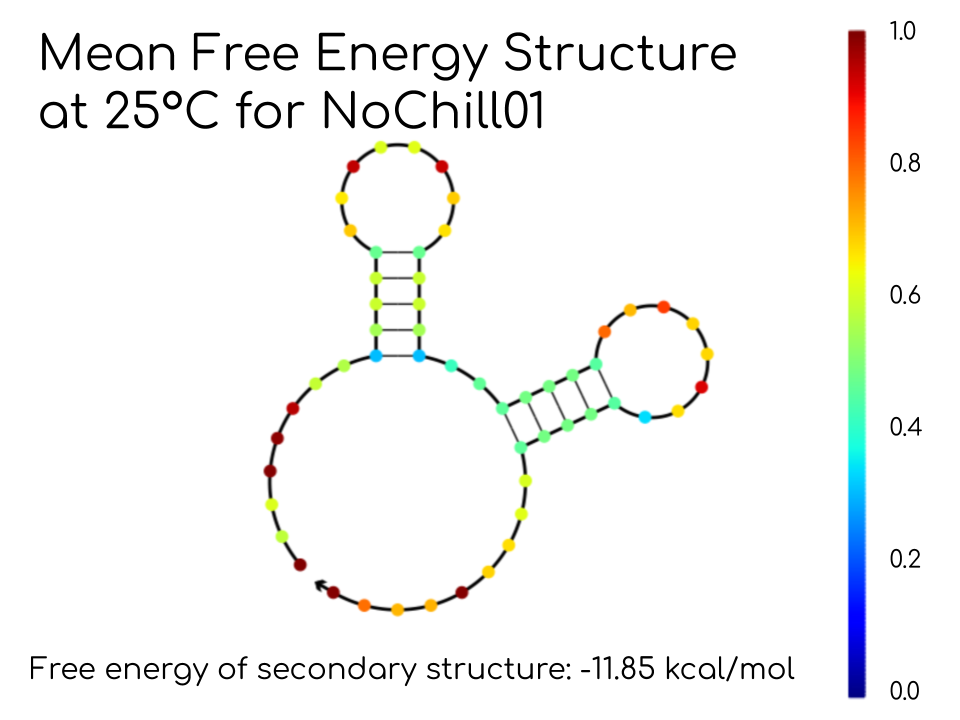Difference between revisions of "Part:BBa K3247000"
ClaireYoung (Talk | contribs) |
ClaireYoung (Talk | contribs) (→Design Notes) |
||
| (10 intermediate revisions by the same user not shown) | |||
| Line 1: | Line 1: | ||
__NOTOC__ | __NOTOC__ | ||
| − | <partinfo> | + | <partinfo>BBa_K3247000 short</partinfo> |
| − | + | RNA thermometers are a form of translational regulation. Our RNA thermometers were designed to have a high fold change between 25°C and 30°C, which is a significantly lower temperature range than existing thermometers that are generally optimized for expression at 37°C or higher. | |
| + | ===Design Notes=== | ||
| + | The stem-loop structure of the thermometer was created by taking the complement of the ribosome binding site (RBS) and adding nucleotides to either side. The additional bases were mutated; the resulting altered sequence is known as the variable region. Mutating the variable region keeps the RBS intact while modifying the RNA thermometer secondary structure to change the melting temperature. There is no internal BsaI cut site, since it would render the thermometer incompatible with our assembly method. The part is TypeIIS compatible. Figure 1a-c showing the RNA thermometer structures were designed using NUPACK software. | ||
| − | == | + | <html> |
| − | + | <img src="https://2019.igem.org/wiki/images/0/07/T--Rice--0125.png" width = 60%> | |
| − | + | <p><b>Figure 1a.</b> Predicted RNA thermometer structure at 25 °C.</p> | |
| − | + | <img src="https://2019.igem.org/wiki/images/5/50/T--Rice--0130.png" width = 60%> | |
| + | <p><b>Figure 1b.</b> Predicted RNA thermometer structure at 30 °C.</p> | ||
| + | <img src="https://2019.igem.org/wiki/images/0/06/T--Rice--0137.png" width = 60%> | ||
| + | <p><b>Figure 1c.</b> Predicted RNA thermometer structure at 37 °C.</p> | ||
| + | </html> | ||
| + | ===Characterization=== | ||
<html> | <html> | ||
| − | <p> | + | <img src="https://2019.igem.org/wiki/images/3/39/T--Rice--Nochill1.png" width = 60%> |
| + | <p><b>Figure 2.</b> Fluorescence intensity at 25 °C, 30 °C, and 37 °C.</p> | ||
| + | </html> | ||
| − | < | + | <partinfo>BBa_K3247000 SequenceAndFeatures</partinfo> |
| − | < | + | |
| − | + | ===Source=== | |
| − | + | ||
| − | + | The thermometers were designed de novo using NUPACK and VSAlgorithm | |
| − | |||
| − | |||
| − | |||
| − | |||
| − | |||
| − | |||
| − | |||
| − | |||
| − | |||
| − | |||
===References=== | ===References=== | ||
| − | + | J. N. Zadeh, C. D. Steenberg, J. S. Bois, B. R. Wolfe, M. B. Pierce, A. R. Khan, R. M. Dirks, N. A. Pierce. NUPACK: analysis and design of nucleic acid systems. J Comput Chem, 32:170–173, 2011. (pdf) | |
| − | + | ||
Latest revision as of 23:29, 21 October 2019
RNA Thermometer NoChill-01
RNA thermometers are a form of translational regulation. Our RNA thermometers were designed to have a high fold change between 25°C and 30°C, which is a significantly lower temperature range than existing thermometers that are generally optimized for expression at 37°C or higher.
Design Notes
The stem-loop structure of the thermometer was created by taking the complement of the ribosome binding site (RBS) and adding nucleotides to either side. The additional bases were mutated; the resulting altered sequence is known as the variable region. Mutating the variable region keeps the RBS intact while modifying the RNA thermometer secondary structure to change the melting temperature. There is no internal BsaI cut site, since it would render the thermometer incompatible with our assembly method. The part is TypeIIS compatible. Figure 1a-c showing the RNA thermometer structures were designed using NUPACK software.

Figure 1a. Predicted RNA thermometer structure at 25 °C.

Figure 1b. Predicted RNA thermometer structure at 30 °C.

Figure 1c. Predicted RNA thermometer structure at 37 °C.
Characterization

Figure 2. Fluorescence intensity at 25 °C, 30 °C, and 37 °C.
- 10INCOMPATIBLE WITH RFC[10]Illegal XbaI site found at 7
- 12COMPATIBLE WITH RFC[12]
- 21COMPATIBLE WITH RFC[21]
- 23INCOMPATIBLE WITH RFC[23]Illegal XbaI site found at 7
- 25INCOMPATIBLE WITH RFC[25]Illegal XbaI site found at 7
- 1000COMPATIBLE WITH RFC[1000]
Source
The thermometers were designed de novo using NUPACK and VSAlgorithm
References
J. N. Zadeh, C. D. Steenberg, J. S. Bois, B. R. Wolfe, M. B. Pierce, A. R. Khan, R. M. Dirks, N. A. Pierce. NUPACK: analysis and design of nucleic acid systems. J Comput Chem, 32:170–173, 2011. (pdf)
